by Ian Skellern
Welcome to the 2016 edition of Quill & Pad’s early Grand Prix d’Horlogerie de Genève predictions in which the team picks favorites and explains why. Please enjoy the opinions of the following panelists:
Ian Skellern (IS), co-founder and technical director
Joshua Munchow (JM), resident nerd writer
GaryG (GG), resident collector
Martin Green (MG), resident gentleman
Alex Ghotbi (AG), watch expert at Phillips and contributor
Ryan Schmidt (RS), author of The Wristwatch Handbook: A Comprehensive Guide to Mechanical Wristwatches and contributor
As a jury member, editor-in-chief Elizabeth Doerr is excluded from these early predictions.
The Calendar category is defined by the GPHG as, “mechanical watches comprising at least one calendar and/or astronomical complication (e.g., annual calendar, perpetual calendar, equation of time, complex moon phase display, etc.). Additional indications and/or complications are admissible.”
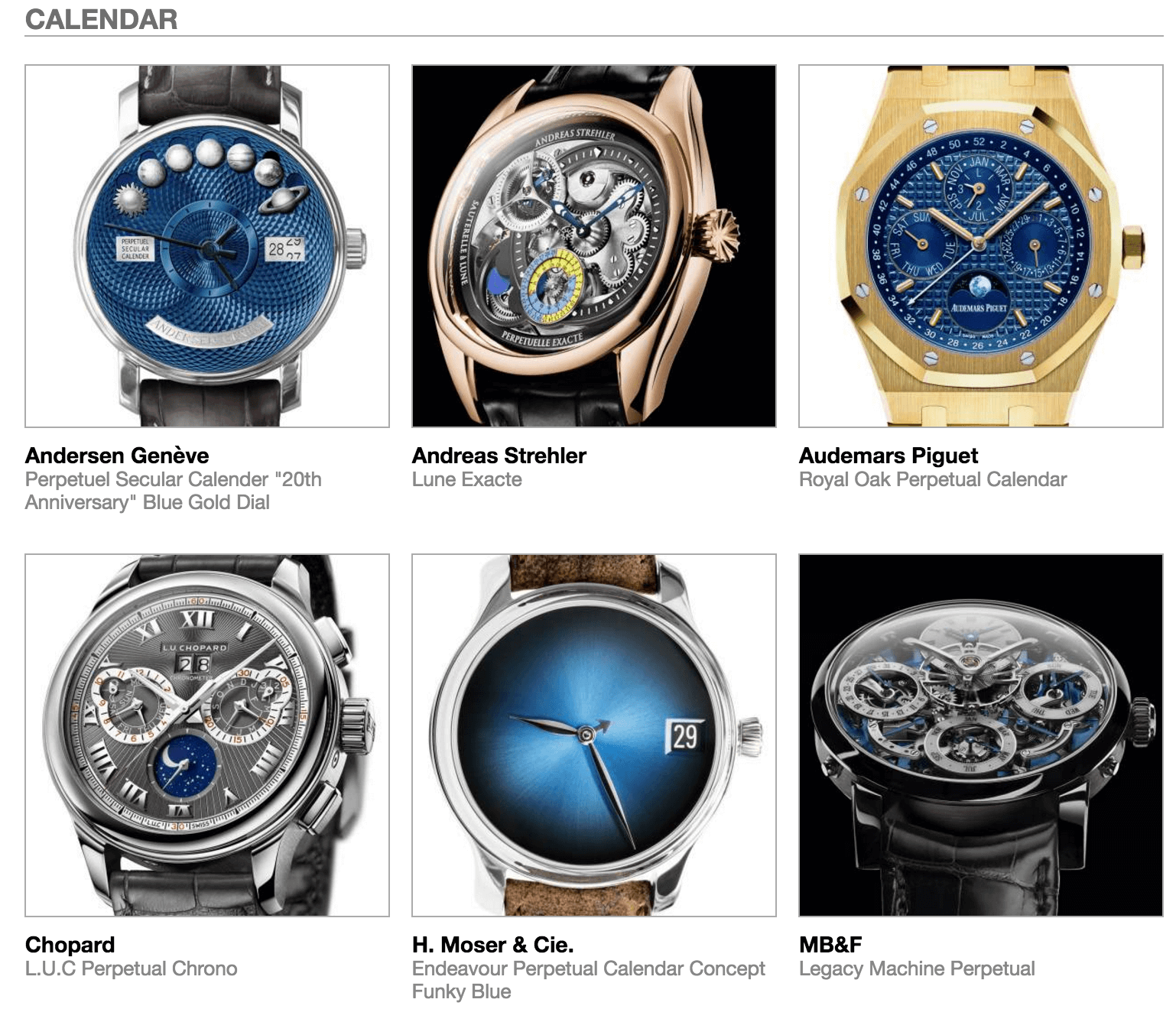
Pre-selected Calendar watches in the 2016 Grand Prix d’Horlogerie de Genève
IS: The year 2016 is really shaping up to be a vintage one for the GPHG with, to my mind, an unprecedented number of strong contenders in each category. That does mean though that the bar is set very high, and it is no longer enough to present a sensational looking, impeccably executed watch and then dust off space on the shelf for the trophy.
In 2016, “sensational looking and impeccably executed” will just get you a seat (if you are lucky) at the big table of pre-selected watches. To have a serious chance of winning this year requires innovation. Serious innovation.
I’m happy to report, though, that there is serious innovation in the Calendar category for 2016.
AG: Indeed, Ian, this is a great selection, varied and attractive! Whereas my first two choices were obvious, third place was a difficult choice.
JM: The Calendar category is, like most of the others, a rather difficult category to choose. The pre-selected watches are all amazing but at the same time very different. The use and aesthetic of each is unique, and the result is a great collection of calendar timepieces. Personal preference definitely comes in to play, but in the end I think one does stand taller than the rest.
GG: What a tough year to be an entrant in this category! All of the makers of the pre-selected watches are to be congratulated on making beautiful, and in many cases tremendously inventive, mechanical marvels.
I pretty much had to flip a coin to split my top two picks, and many of the others weren’t far behind in my reckoning. What a group of candidates!
Audemars Piguet Royal Oak Perpetual Calendar
IS: When it comes to perpetual calendar wristwatches, the Audemars Piguet Royal Oak Perpetual Calendar is a true classic and a blue dial in a yellow gold case is a match made in design heaven. The good news continues under the skin as well, as this Royal Oak Perpetual Calendar is powered by Audemars Piguet’s relatively new Caliber 5134, which, while based on the previous Caliber 2120, has been updated and enlarged to fit today’s larger case diameters.

Audemars Piguet Royal Oak Perpetual Calendar
Visually I like the blue dial with its Grande Tapisserie guilloche, and technically I like the way that the automatic rotor runs on a peripheral ring supported by four ruby runners to minimize friction and wear. The 2.75 Hz / 19,800 bph balance beats at an unusual frequency, but I’m sure that there is a good reason for that. The 40-hour power reserve looks low compared to the competition here, though.
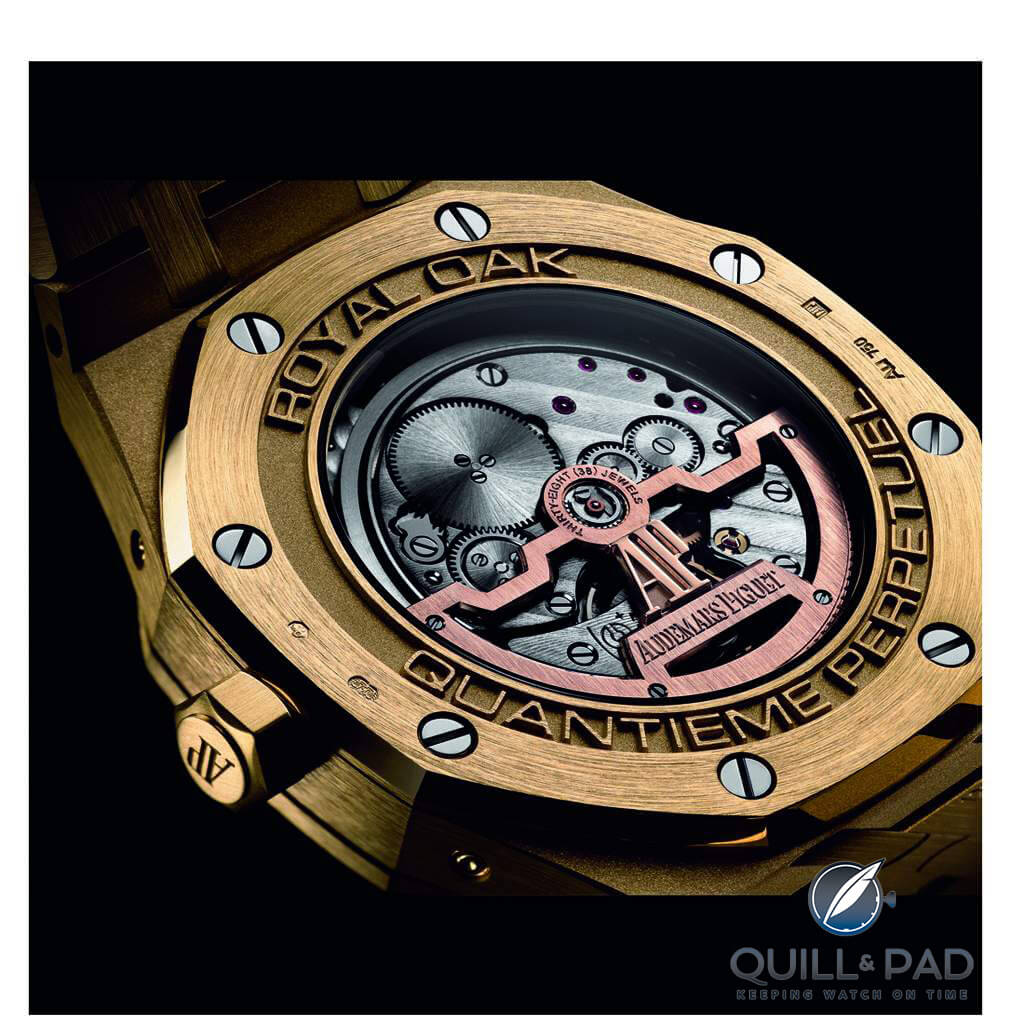
Back of the Audemars Piguet Royal Oak Perpetual Calendar
The Audemars Piguet Royal Oak Perpetual Calendar is a watch any collector would be happy to have; however, I can’t help but feel that it is too much another variation on what’s been done before rather than offering enough of the “new” that will distinguish the winner here.
AG: Do I actually have to give a reason for liking this? The Royal Oak is one of the most beautiful designs ever and in all gold with a perpetual calendar it has extra flamboyance, which makes this watch so sexy!
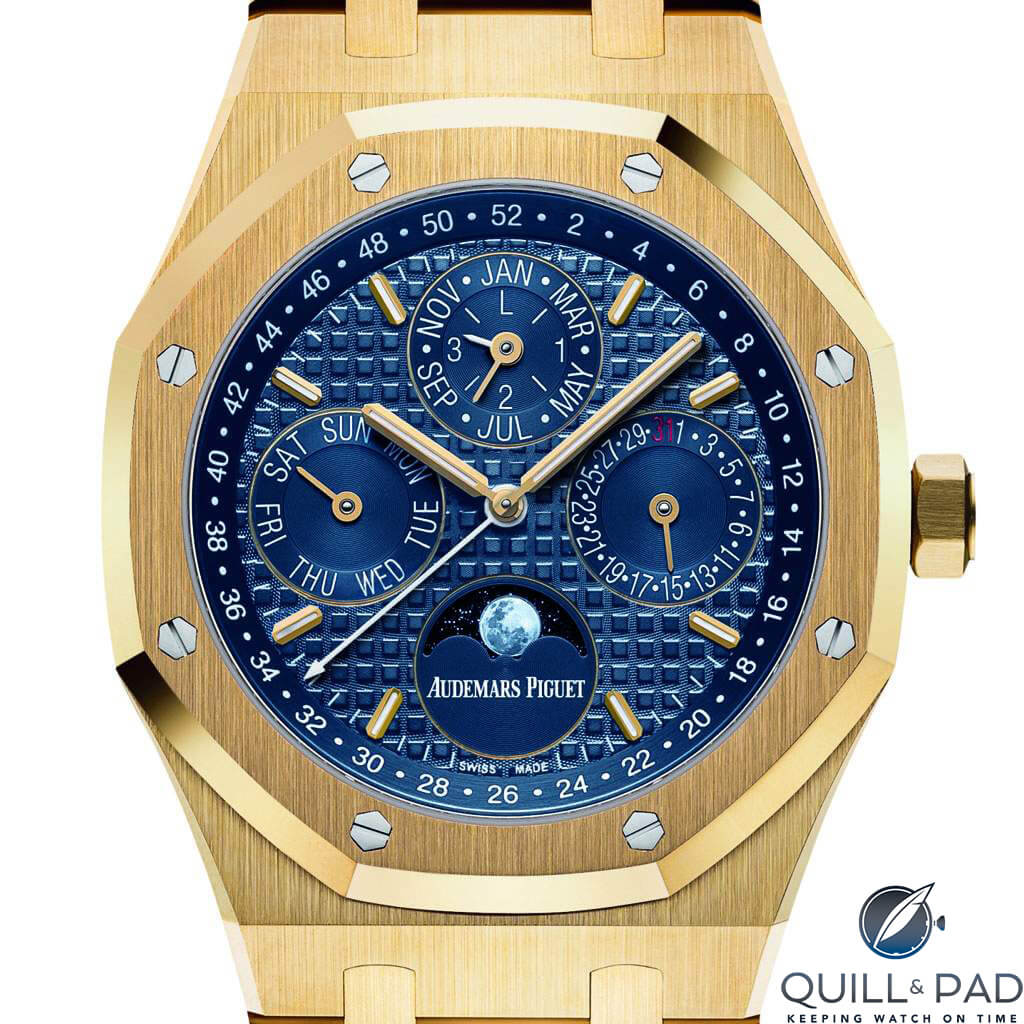
Audemars Piguet Royal Oak Perpetual Calendar
RS: This is a stunning perpetual calendar housed in a magnificent case. However, what fresh innovation Caliber 5134 brings to us in 2016 is a larger diameter and a 52-week business counter. It’s beautiful, but I just don’t think that it’s enough to take the crown in this category.
Further reading: Will Yellow Gold Find Its Way Back To The Wrist Soon? Audemars Piguet Thinks So With A Whole New Collection Of Royal Oaks.
For more information, please visit http://www.gphg.org/horlogerie/en/watches/royal-oak-perpetual-calendar.
Audemars Piguet Royal Oak Perpetual Calendar
Case: 41 mm, yellow gold
Movement: automatic Caliber 5134 beating at 2.75 Hz / 19,800 vph
Functions: hours, minutes; perpetual calendar with date, weekday, month, moon phase, leap year, calendar week
Price: $95,700 / 89,100 Swiss francs
Moser & Cie. Endeavour Perpetual Calendar Concept Funky Blue
IS: I like simplicity and clean dials and appreciate that it usually takes a lot of complexity under the hood to make things simple above it. Which is a long-winded way of saying that the H. Moser & Cie. Endeavour Perpetual Calendar Concept Funky Blue is my kind of watch.
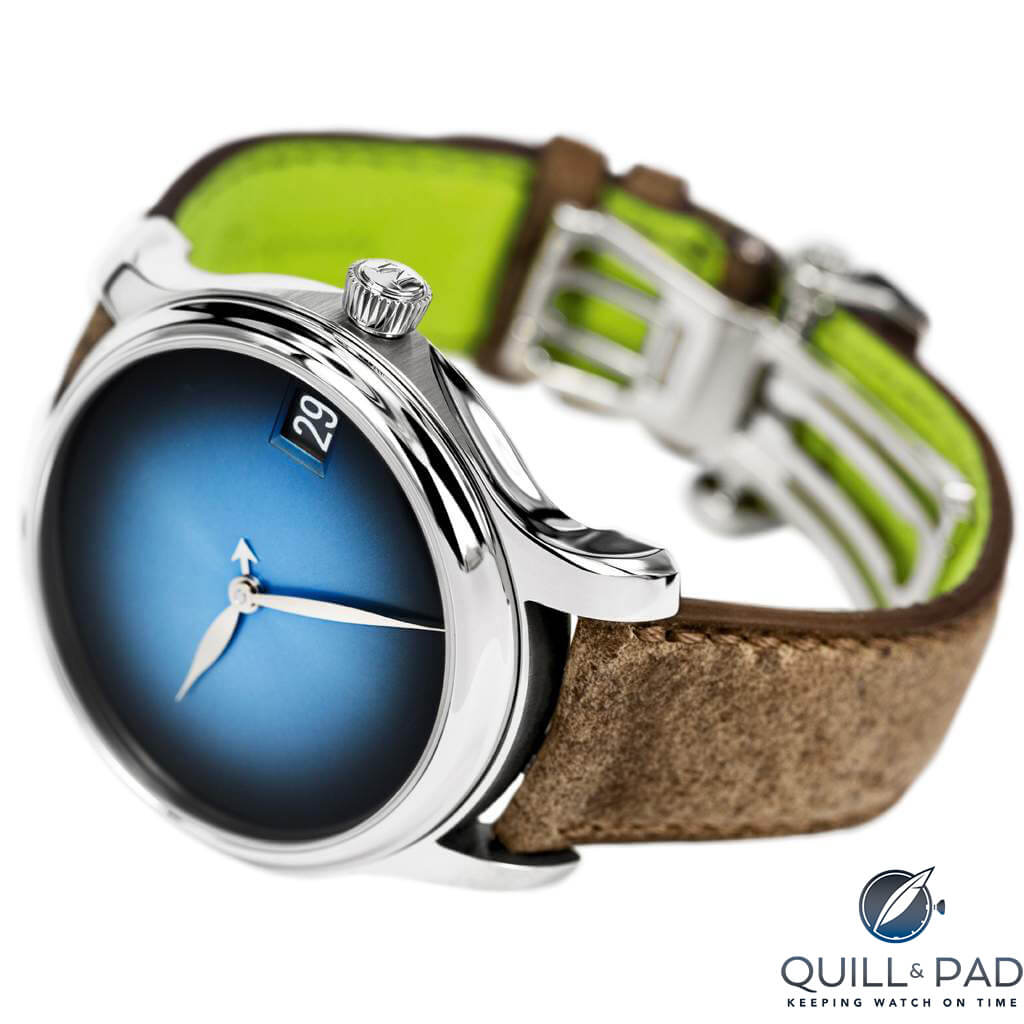
H. Moser & Cie. Endeavour Perpetual Calendar Concept Funky Blue
Unusually for a perpetual calendar, the H. Moser & Cie. features a manual winding movement (automatic winding makes it easy to keep perpetual calendars continually running so that they do not need constant resetting if worn intermittently). The generous seven-day power reserve though substantially makes up for the lack of automatic winding.
What I also like about the Moser perpetual is that it is relatively idiot-proof in that the hands can be set forward and backward.
But the real feature of the Perpetual Calendar Concept Funky Blue is just how much information is displayed by so few indications: just two hands (hours, minutes), one arrow (month), one large date, and a star on the back of the movement displaying the leap year cycle.
My only minor gripe is that I’d prefer the date ring to be the same blue as the dial, but I’ve no doubt that legibility is better with the white-on-black date.
While the H. Moser & Cie. Endeavour Perpetual Calendar has been around for a few years, this pared-down-to-the-bone minimalist rendition does offer something truly fresh, especially as one of the largest issues with perpetual calendars is lack of legibility in displaying too much.
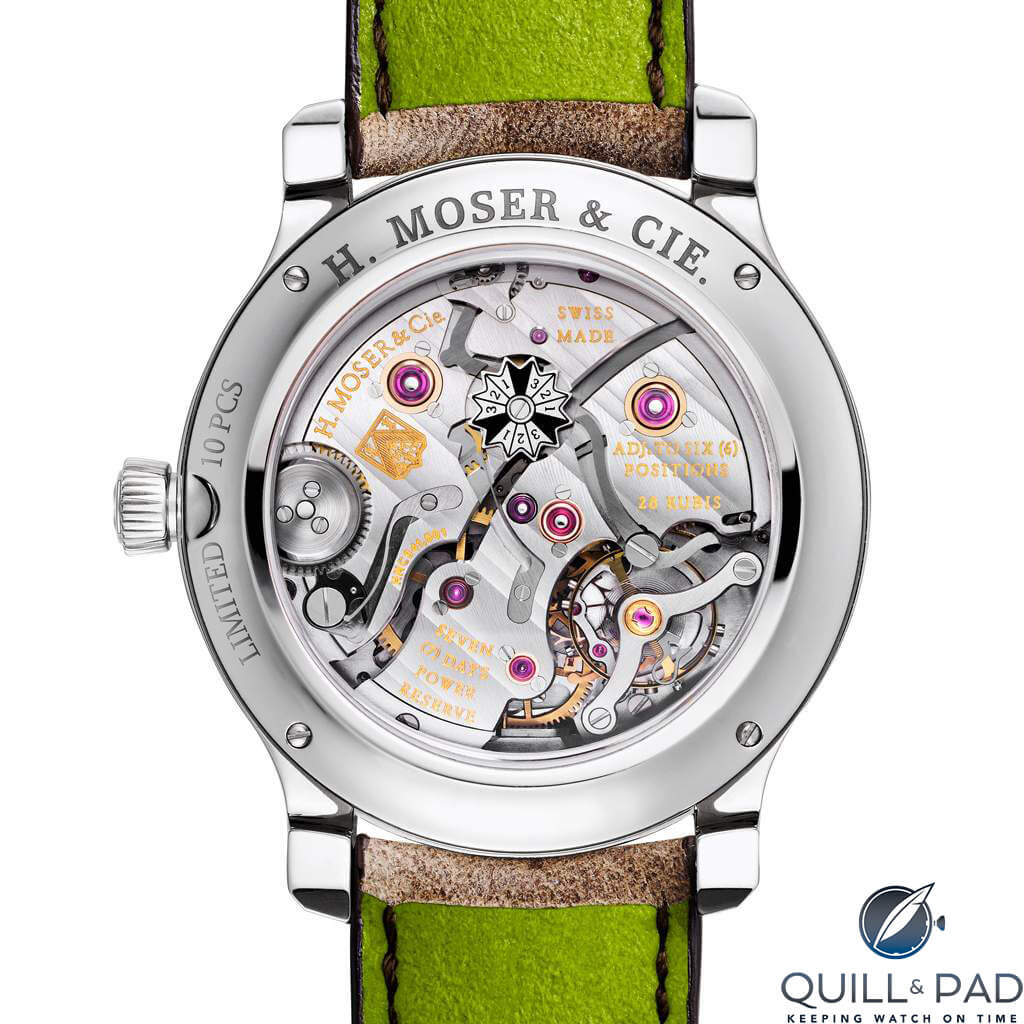
View through the display back to the movement of the H. Moser & Cie. Endeavour Perpetual Calendar Concept Funky Blue
RS: I am a huge fan of the Moser Endeavour Perpetual Calendar and of the “blank slate” of the Endeavour Centre Seconds Concept Funky Blue, and I admire Moser’s overall reductionist approach to fine watchmaking; however I do believe that some might find this a step too far. There is perhaps something of the joy of the perpetual calendar that is lost on such a sparse dial, something that Moser worked hard to retain with deft skill in their regular collection model.
What’s more, I do not feel that there is enough being presented here for the first time to stand tall against the heavyweights that occupy this category.
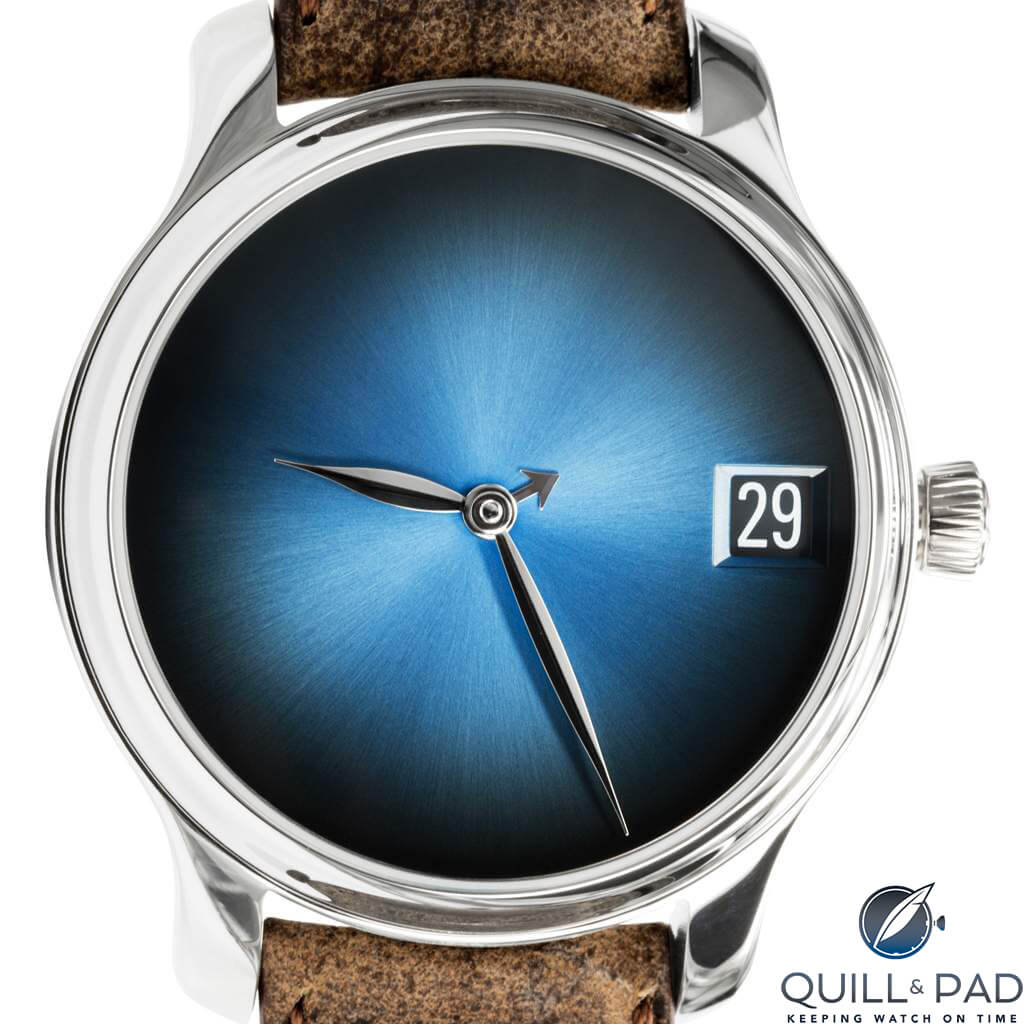
H. Moser & Cie. Endeavour Perpetual Calendar Concept Funky Blue
JM: This watch is sort of the antithesis to perpetual calendar watches as it features no subdials, one digital display, and keeps the dial as uncrowded as it possibly could, while simultaneously be displaying all the relevant information as clearly yet minimally as possible. Moving the leap year indicator to the rear of the movement allows a completely stark display, too.
It might just be one of the top understated perpetual calendar watches in existence. And that is worth celebrating.
Further reading: Heartbeat: U2’s Adam Clayton Visits SIHH 2016 Wearing H. Moser & Cie Endeavour Perpetual Calendar.
For more information, please visit www.gphg.org/horlogerie/en/watches/endeavour-perpetual-calendar-concept-funky-blue.
Quick Facts Endeavour Perpetual Calendar Concept Funky Blue
Case: 40.8 x 11.1 mm, stainless steel
Movement: manually wound Caliber HMC 341 with seven-day power reserve (twin spring barrels) and Straumann (in-house) hairspring and pallet fork and escape wheel in gold; 18,000 vph/2.5 Hz frequency
Functions: hours, minutes; large date, perpetual calendar with months (shown by small arrow), leap years on back
Limitation: 10 pieces
Price: 60,000 Swiss francs
Chopard L.U.C Perpetual Chrono
IS: I have the same issue with the Chopard L.U.C Perpetual Chrono as I did with the Audemars Piguet Royal Oak Perpetual Calendar: great watch and movement, but too similar to what we have already seen before. I offer a tip of the hat to Chopard for the use of certified Fairmined gold (see Chopard L.U.C XPS And Tourbillon QF In Fairmined Gold: Making A Sustainable Difference) and that the L.U.C Perpetual Chrono is also C.O.S.C.-certified to chronometer-standard precision.

Chopard L.U.C Perpetual Chrono
I also think that Chopard has done an excellent job in laying out the information on the dial in a logical and legible manner, it isn’t easy just displaying perpetual calendar functions clearly, let alone having to include chronograph subdials in the mix.

Chopard L.U.C. Perpetual Chrono
GG: In any other year, the Chopard might have walked away with this category, so I’d like to grant it an honorable mention. I’m a sucker for this combination of complications, and the white gold / grey dial combo is very much to my taste as well. Excellent movement and finishing and a really dramatic appearance on the dial side to boot. My only reservation is the size of this one at 45 x 15 mm, but I might even get used to that!
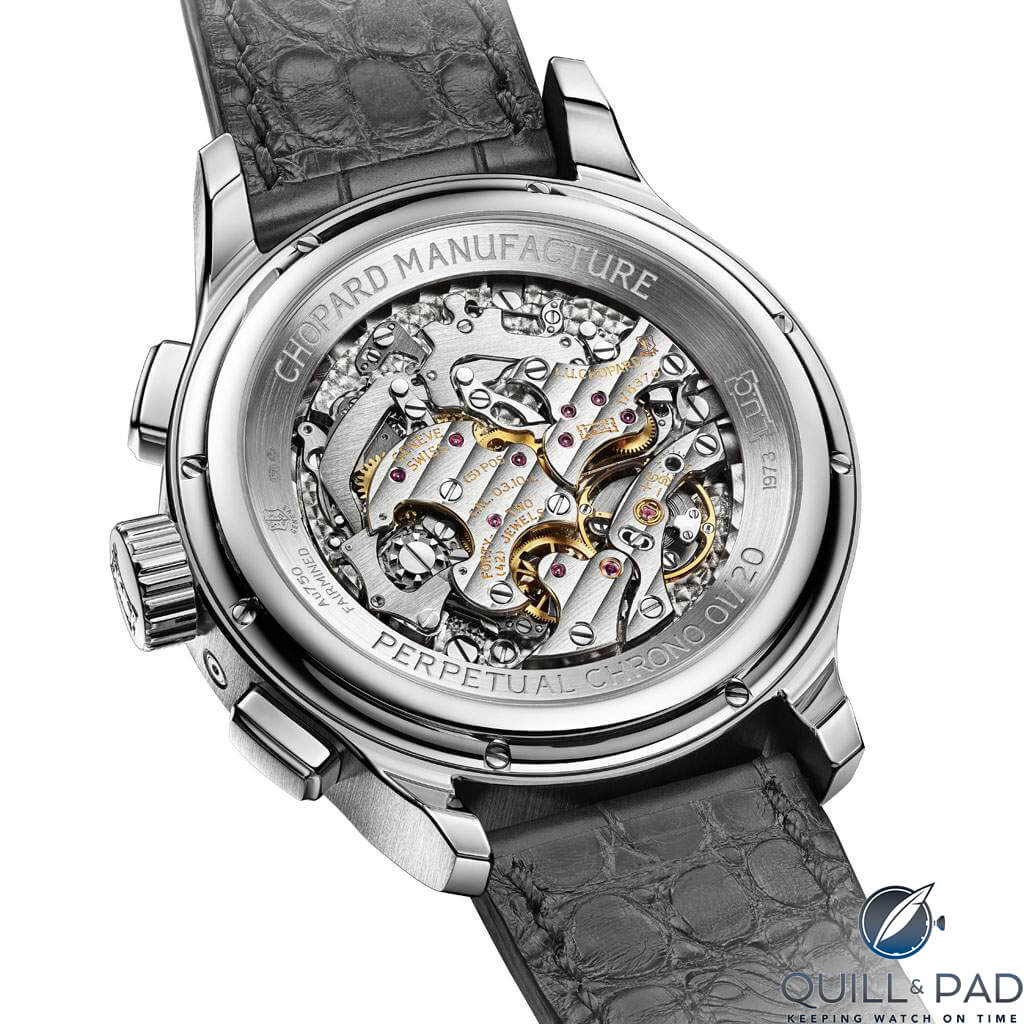
View through the display back to the beautiful movement of the Chopard L.U.C Perpetual Chrono
RS: The only entrant to throw a chronograph into the mix, this C.O.S.C.-rated, Geneva-sealed powerhouse deserves very serious recognition. The only high-end manually wound vertical clutch chronograph on the market that I can think of, it’s special to say the least.
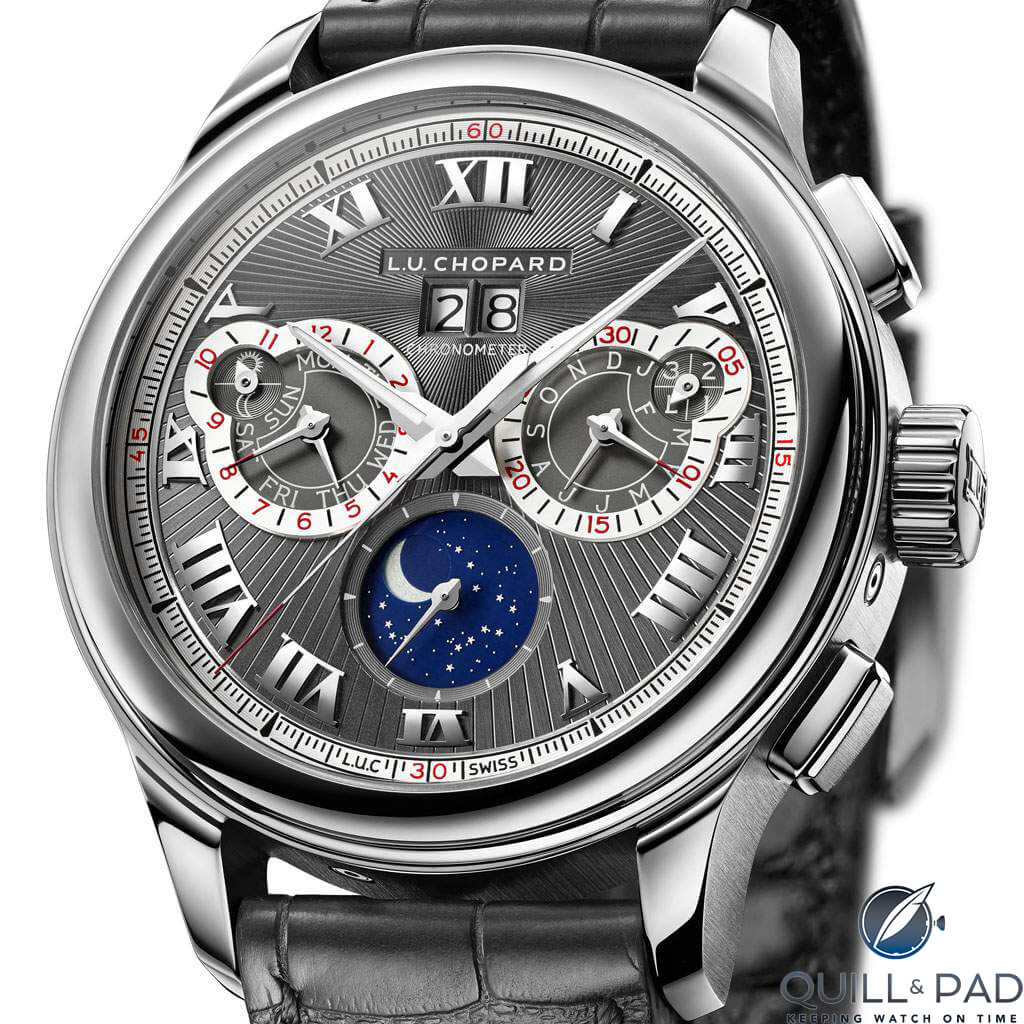
Chopard L.U.C Perpetual Chrono
Further reading: Chopard L.U.C. Perpetual Chrono: Who Do You See?
For more information, please visit www.gphg.org/horlogerie/en/watches/luc-perpetual-chrono.
Quick Facts Chopard L.U.C Perpetual Chrono
Case: 45 x 15.06 mm, white fairmined gold
Movement: manually wound Caliber L.U.C. 03.10-L with 60-hour power reserve, certified by C.O.S.C. and Seal of Geneva
Functions: hours, minutes, seconds; perpetual calendar with day, date, month, leap year, moon phase, day/night indicator, flyback chronograph
Limitation: 20 pieces
Price: $95,630 / 85,000 Swiss francs
Andersen Genève Perpetuel Secular Calendar “20th Anniversary” Blue Gold Dial
RS: It’s not new, but it’s new for this millennium, and it’s rip-roaringly fantastic. Can we agree that it qualifies? I think so. There are four things I love about the Secular Perpetual Calendar. First, the complication handles those three occasions every 400 years that the leap year rule is not applied (yes, this movement has a 400-year function!); second, the weekday apertures are lots of fun; third, the bulk of the calendar displays are displayed through the sapphire crystal case back; and fourth, blue gold! In my opinion, it’s an extremely well earned second place.
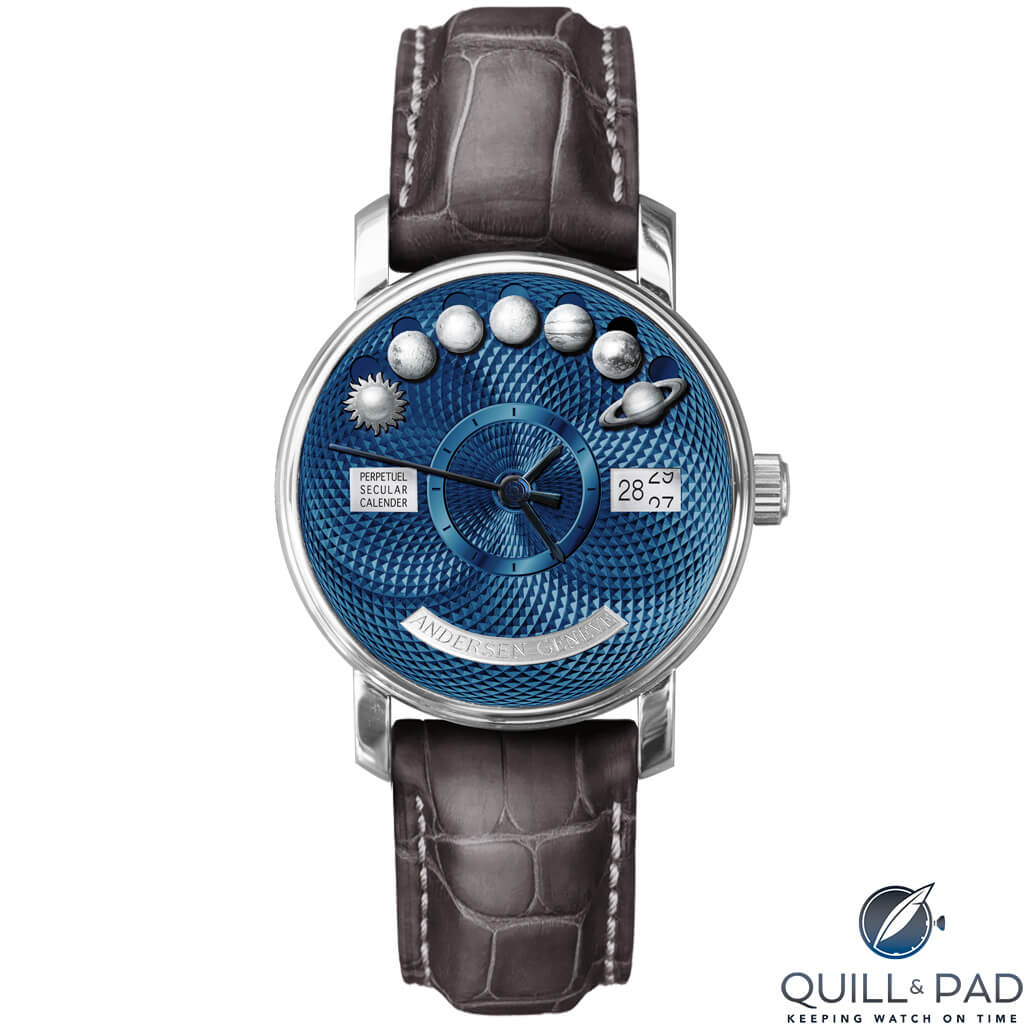
Andersen Genève Perpetuel Secular Calendar “20th Anniversary” Blue Gold Dial
IS: What really makes the Andersen Genève Perpetual Secular Calendar “20th Anniversary” stand out from the competition here is the seven planets around the top of the dial that represent the days of the week: Sun/Sunday, Moon/Monday, Mars/Tuesday, Mercury/Wednesday, Jupiter/Thursday, Venus/Friday, and Saturn/Saturday.
And then there’s that gorgeous guilloche heat-blued-gold dial that Andersen is so well known for.
Svend Andersen introduced the first true secular perpetual calendar watch in 1996 and this new model commemorates that complication’s twentieth anniversary.
If you are wondering how the dial can be so clean for a perpetual calendar, it is because the less frequently accessed indications – the months, years and leap year cycle – are all displayed on the back of the movement.
The Andersen Genève Perpetual Secular Calendar “20th Anniversary” Blue Gold Dial is a beautiful watch, impeccably executed, and well deserves its place in this high-caliber company.
AG: This was a hard choice because the Strehler is very interesting and the Moser is quite attractive, but my vote goes to Svend Andersen. He is one of the founding fathers of the A.H.C.I., but doesn’t seem to get much coverage [but we cover him: see Worldtimers, Erotic Watches, And Poker-Playing Dogs: A.H.C.I. Co-Founder Svend Andersen Has (Semi-)Retired, But His Brand Lives On].
This piece definitely bears his genetic codes with the superbly blue guilloche dial and the secular perpetual calendar (which needs setting only every 400 years!), which he had launched 20 years ago. The addition of the planets on the dial for indication of the day is a nice touch.
GG: The Andersen is based on his original secular calendar of 20 years ago, but adds a clever day-of-week indicator that for me makes it a “new” watch for the purposes of this competition. If Strehler has the moon phase contest won, Andersen must be close to that on date indications with his calendar, which in addition to functioning as a traditional perpetual calendar accounts for the non-leap years that fall on each century, and with its 400-year cycle only requires that the wheel indicating the centuries be updated in the year 2400. Not bad!
JM: This watch represents something unique in the category: a full perpetual calendar, meaning that it even accounts for the non-leap year centuries. Originally released in 1996 – hence the “twentieth anniversary” – this watch was the first of its kind and still remains one of the only wrist calendars of its kind. It is truly rare.
This update features an added day of the week complication display using the sun, moon, and first five planets. The layout is kept simple and the dial is extraordinary to gaze upon. The incredible blue guilloche combined with the miniature celestial bodies creates a winning combination and if not for one other timepiece, would be my winner for this category.
For more information, please visit http://www.gphg.org/horlogerie/en/watches/perpetuel-secular-calender-20th-anniversary-blue-gold-dial.
Quick Facts Andersen Genève Perpetuel Secular Calendar “20th Anniversary” Blue Gold Dial
Case: 42.8 x 11 mm, platinum
Movement: unspecified vintage automatic caliber
Functions: hours, minutes, seconds; perpetual secular calendar with day, date, month, year
Limitation: 20 pieces
Price: 148,000 Swiss francs
Andreas Strehler Lune Exacte
MG: A moon phase so exact that it deviates by one day from the mean moon in 2,060,757 years is of course incredible in every way, shape, or form. What really makes this watch special to me is that this is not a boring statistic in the Guinness Book of World Records that you just happen to wear on your wrist, but that you can actually see this accuracy on the dial.
The patent pending Vernier scale on the dial makes the technical accomplishments of Strehler visual and tangible, leaving you only more in awe. The fact that he also houses this complication in a jaw-droppingly beautiful case allows me to predict that he will take home the top honor in this category.
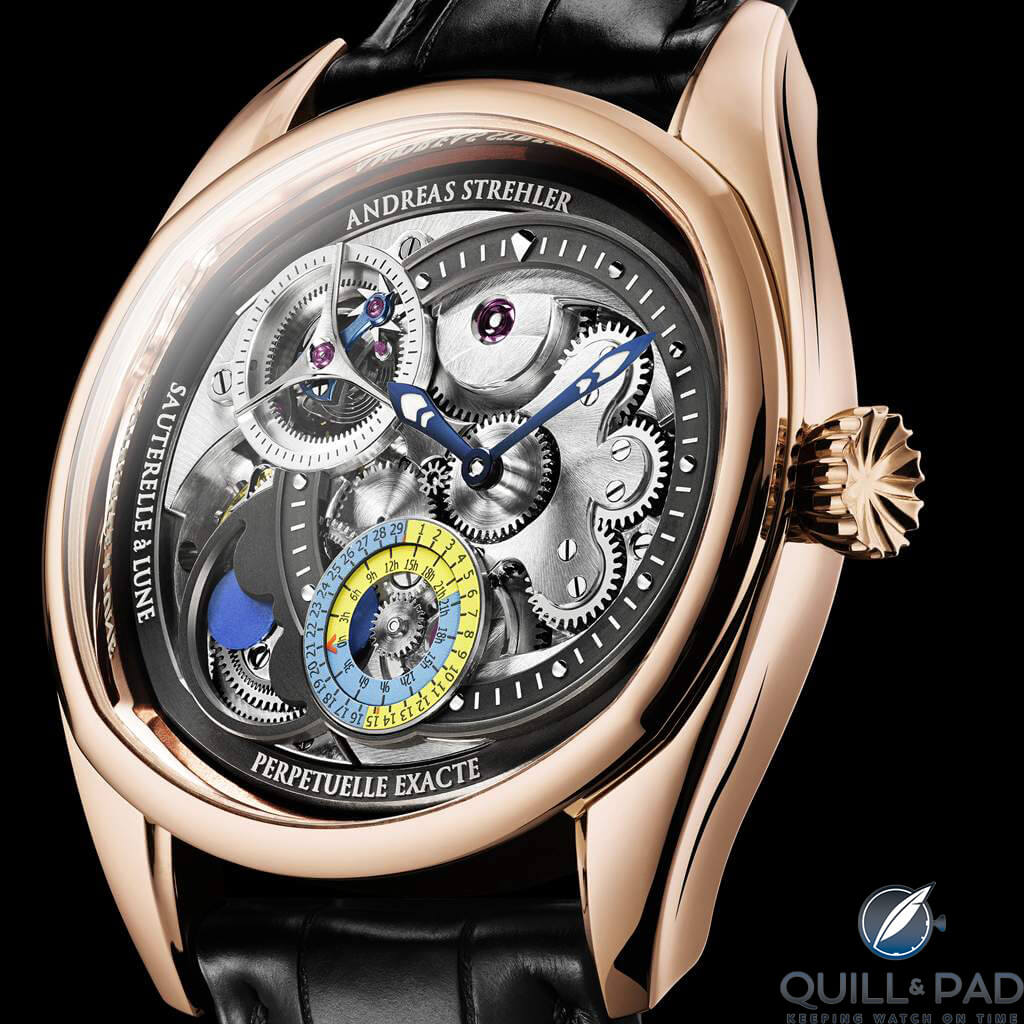
Andreas Strehler Lune Exacte
IS: It’s not a perpetual calendar, the Andreas Strehler Lune Exacte simply displays the hours, minutes, seconds, and moon phase. Reading that, you would be forgiven for wondering how it made it through the pre-selection process.
But what a moon phase: Strehler has not been content to simply interpret or reinterpret what’s been done in the past, but rather to better what’s been done in the past. Moon phase indications are usually good for a hundred or so years before they need recalibrating because the moon doesn’t orbit in a nice, round number of days or hours.
Strehler has managed to develop a compact moon phase complication that is accurate to one day every two million years! And not only that, the indication can be read so that you can tell the phase of the moon down to an accuracy of just three hours. That’s incredible.
What I also like about this watch is that Strehler has included both his patented remontoir d’égalité (constant force device) and epicyclic stop work gearing that ensures that only optimal torque is used from the two spring barrels. That means that it’s not just the moon phase indication that is exact, but also the time.
As good as the Andreas Strehler Lune Exacte is, I only pick it as my runner up as I feel it has been bettered in this category. However, if, as I predict, the MB&F Legacy Machine Perpetual takes the Aiguille d’Or, then I think that the Lune Exacte will be best Calendar watch 2016.
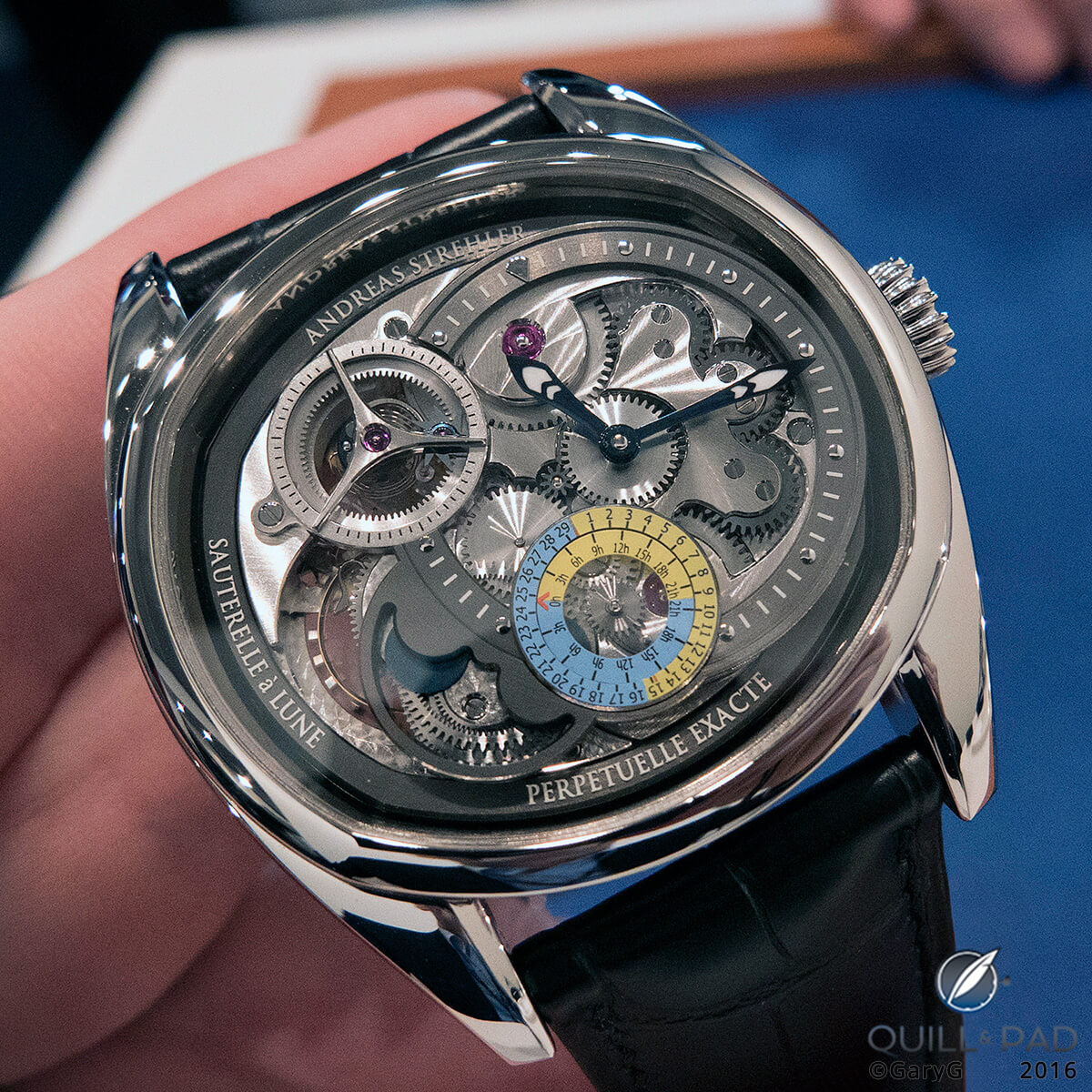
Andreas Strehler’s Sauterelle à Lune Exacte has a moon phase display accurate to two million years
GG: I was still tempted to pick the Strehler as the Calendar watch of the year. Let’s face it: a moon phase that is accurate to one day in two million years has pretty much put the competition to rest!
The Vernier scale that allows the age of the moon within its (approximately) twenty-nine and one half day cycle to be read with an accuracy of three hours is pretty tricky, too. And when Andreas incorporates a remontoir and includes his usual splendid finishing work, all in a beautifully shaped case, it’s very hard to resist this piece!
My only small niggles with this watch are the slight difficulty of seeing the moon disk itself (Andreas told me that he tried a number of color combinations and this one was the best of the bunch) and the “technical” appearance of the Vernier scale that might have been softened a bit by the use of non-primary colors.
Those are small reservations indeed, however, and if it weren’t for the presence of the MB&F Legacy Machine Perpetual this watch would have been my clear winner.
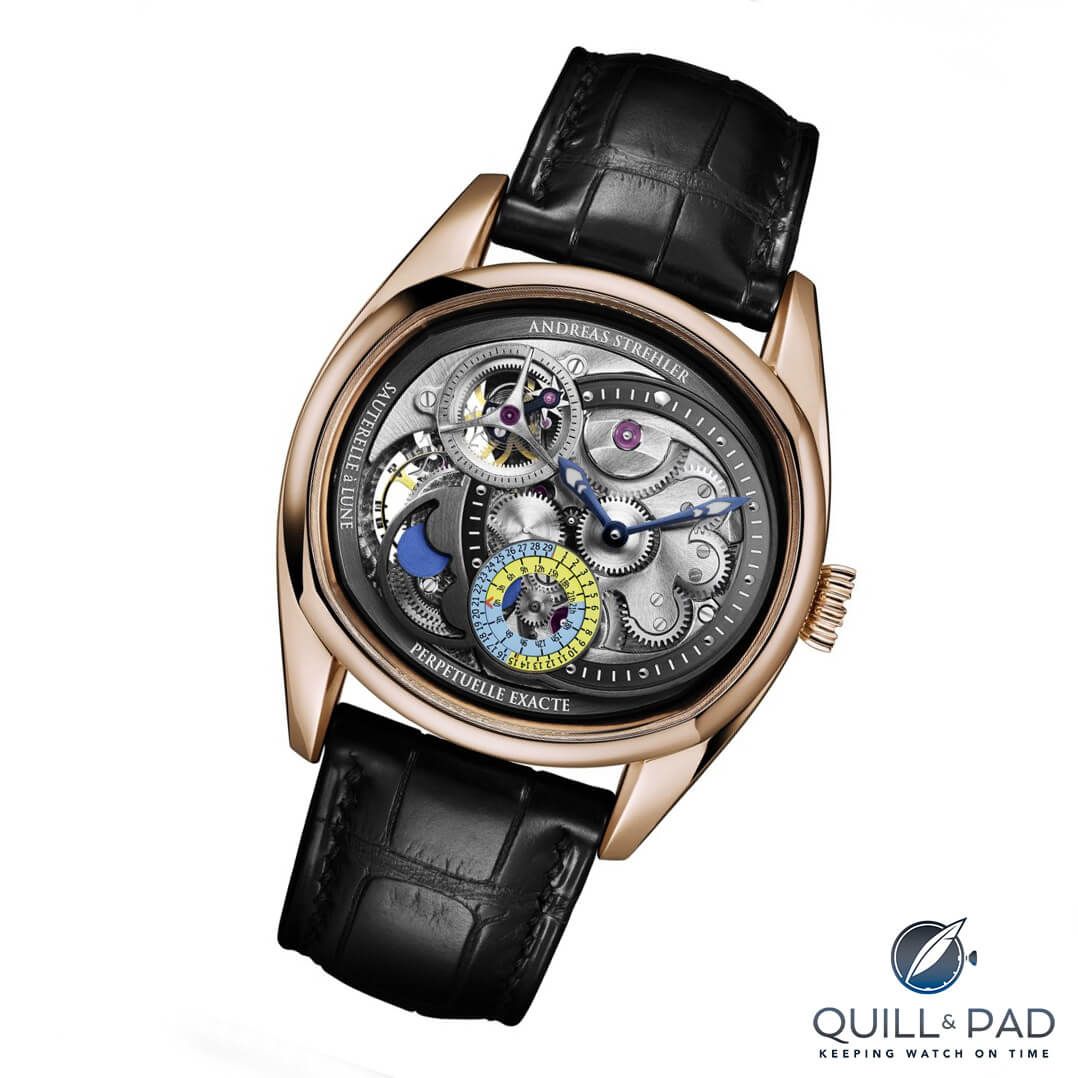
Andreas Strehler’s Sauterelle à Lune Exacte has a moon phase display accurate to two million years
RS: Delivering moon phase complications of staggering accuracy, Strehler is to the moon phase what Svend Andersen is to the perpetual calendar. Those who know about the Sauterelle à Lune Perpétuelle 2M will only experience a momentary shock as to how equally accurate the mechanism of the Lune Exacte is, but it’s the setting and reading of the age of the moon that gets the Strehler treatment this year.
Using a unique circular Vernier scale on the dial one can determine or set the exact age of the moon to the nearest three hours. Reading the indication is hard to grasp at first, but once you get the hang of it it’s easy and satisfying! I recommend this link for the clearest instructions: www.astrehler.ch/read-moon-vernier-scale-featured-lune-exacte.
Further reading: Objects Of Desire: Independent Watches At Baselworld 2016 and The 8 Most Accurate Moon Phase Wristwatches Today.
For more information, please visit www.gphg.org/horlogerie/en/watches/lune-exacte.
Quick Facts Andreas Strehler Lune Exacte
Case: 41 x 37.3 x 10 mm, red gold
Movement: manually wound manufacture Caliber Sauterelle Lune Exacte outfitted with remontoir d’égalité for constant force
Functions: hours, minutes, seconds; perpetual moon phase, which needs adjustment by one day only every 2 million years, moon age indication via vernier scale
Price: 112,000 Swiss francs plus applicable tax
MB&F Legacy Machine Perpetual
JM: Alas, it always comes back to MB&F, doesn’t it? This brand makes some truly outstanding watches and works with extremely talented people to create things never before imagined. The Legacy Machine Perpetual is no different. The movement was developed from the ground up as a wholly integrated machine, redesigning how a perpetual calendar functions. Safety and movement longevity were considered as well as beauty.
Being built in the Legacy Machine style was probably the smartest move, as it pops like almost nothing else on the market. And the wonderful movement is completely visible from the dial side, allowing true appreciation for the magic within. It might well be one of the best watches of the year and it definitely stands out as the top perpetual calendar of this year. I can’t praise this watch enough and hope the jury agrees with my sentiments!
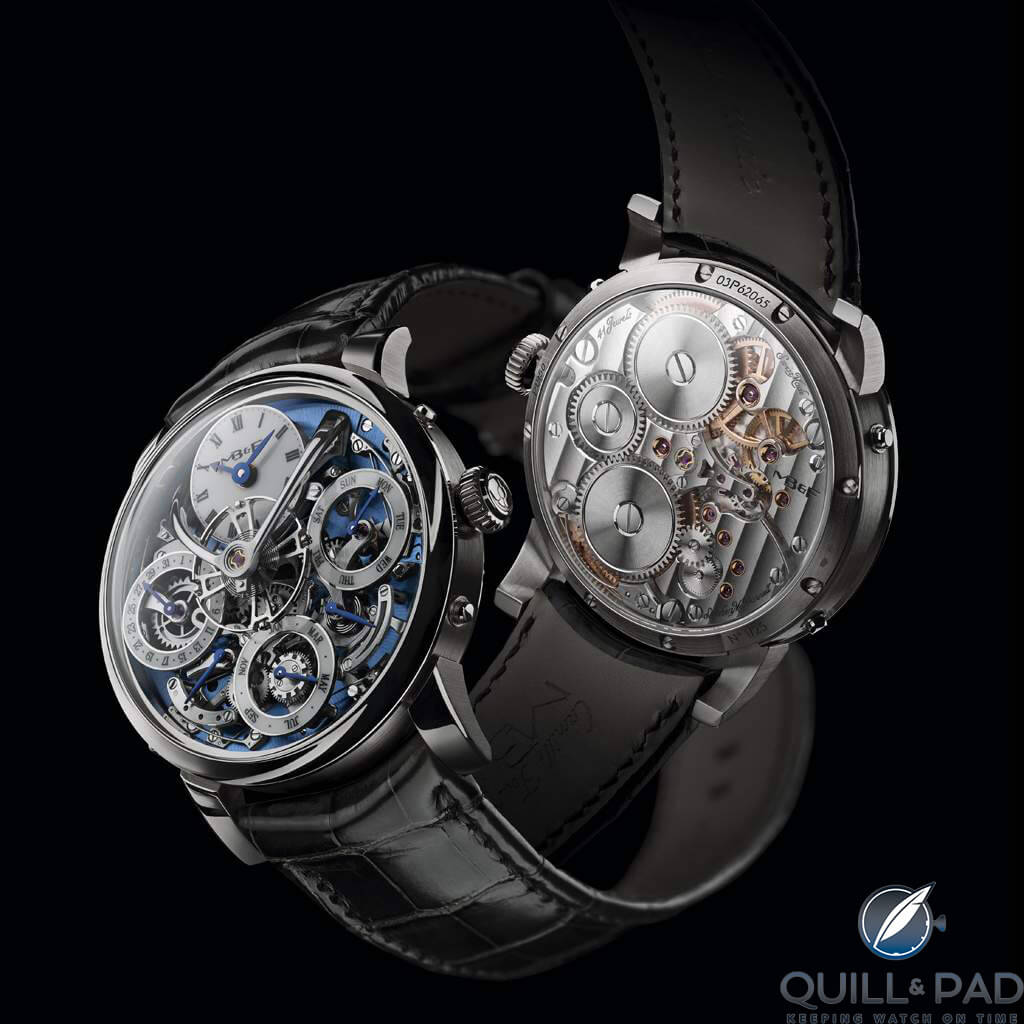
MB&F Legacy Machine Perpetual front and back
IS: The MB&F Legacy Machine Perpetual is my favorite from the Calendar category of the 2016 GPHG, and I predict that if it does not win this category it will be because it takes the big prize: the Aiguille d’Or.
The vast majority of watches we see today, even the most complicated, are basically iterations of what has been done in the past, often hundreds of years into the past, with very little change to the basic movement architecture. Until now.
Traditional perpetual calendar mechanisms use a 31-day month as a default and “skip” superfluous dates for the months with fewer days, basically by fast-forwarding through the redundant dates during changeover. A traditional perpetual calendar changing from February 28 to March 1 scrolls quickly through the 29th, 30th and 31st to arrive at the 1st. And in those instances the mechanism can jump or jam.

MB&F Legacy Machine Perpetual on the wrist
Mechanically there is a lot going on when a traditional perpetual is changing the date and who betide anybody that mistakenly tries to set their watch while that is going on, as the chances of breaking something are high.
For Legacy Machine Perpetual, MB&F worked in collaboration with Irish watchmaker/movement designer Stephen McDonnell to come up with something different, and he succeeded in completely reinventing the perpetual calendar.
Instead of taking the default length of a month at 31 days then skipping unnecessary dates in short months, McDonnell invented a mechanical processor that uses a default month length of 28 days to which it adds extra dates as required. No skipping dates, a less complicated mechanism, and with built-in fail safes it’s less far less-likely to be damaged.
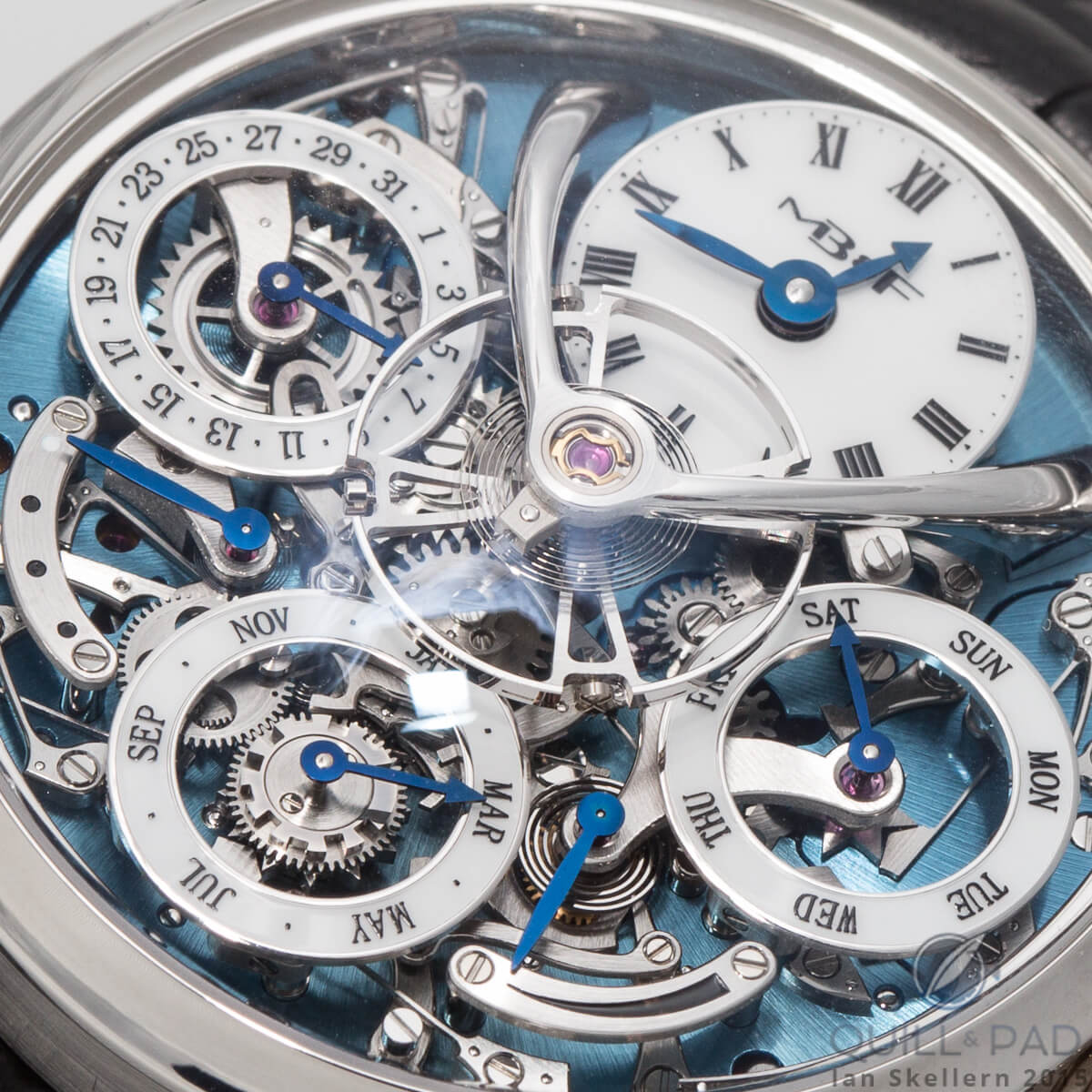
A close look at the MB&F Legacy Machine Perpetual’s complication, which sits above the blue (in the platinum model) main plate of the movement
And there’s more. McDonnell’s mechanical processor replaces what is called on a traditional perpetual calendar the “big lever,” which coordinates the various functions of the compilation. That big lever meant that it was always difficult to show much of the mechanism, as the big lever required so much space. McDonnell’s innovation has allowed for the perpetual calendar mechanism to be built on top of the fully integrated movement so it can be fully appreciated in operation.
And there are quickset pushers (all fail safe) for all of the indications, including the leap year cycle. That alone would be enough to win this category!
The MB&F Legacy Machine Perpetual looks fantastic and heralds the biggest advance in one of the most traditional of complications in decades, if not centuries, and the only reason I can see it not taking the award for best Calendar watch 2016 is if it (justifiably) wins the Aiguille d’Or.
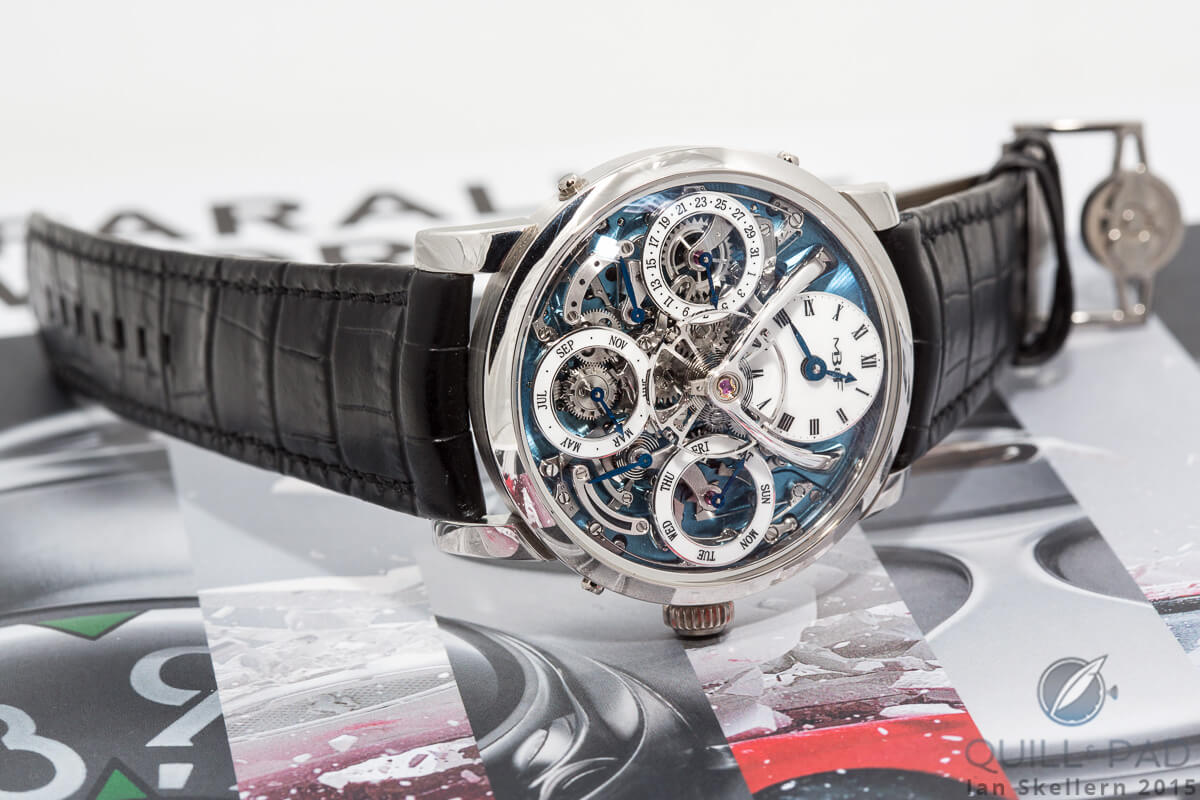
MB&F Legacy Machine Perpetual in platinum
AG: I can put that more simply, Ian: what a cool watch! The fold at MB&F has done a tremendous job here by completely reinventing the perpetual calendar. I believe this is the very first time in a wristwatch where the perpetual calendar mechanism is fully integrated and not modular, which permits having such an architectural movement construction.
With this watch, MB&F has taken a classical complication and injected it with its artistic sensitivity. The final result is superb!
GG: I first was granted the opportunity to see this watch in November of 2015 at the M.A.D.Gallery in Geneva, and it absolutely blew me away. While it’s absolutely faithful to the established design codes of the Legacy Machine series, this watch has an aesthetic charm and refinement that, for me, puts it head and shoulders above the other Legacy Machines.
Then, we have the perpetual mechanism itself, brilliantly based on the idea of a 28-day default month rather than the 31-day convention observed by prior perpetual calendar architectures. Going to the 28-day month and basing the calendar complication on a compact mechanical processor rather than a long lever reaching across the face of the movement also enabled wonderful visual treats including sub-dials that appear to float on air but in reality are anchored by studs to the plate below.
The hits go on and on: quickset year, impossible-to-foul date mechanism, “floating” balance affixed to the longest balance shaft made, and more. And it looks great!
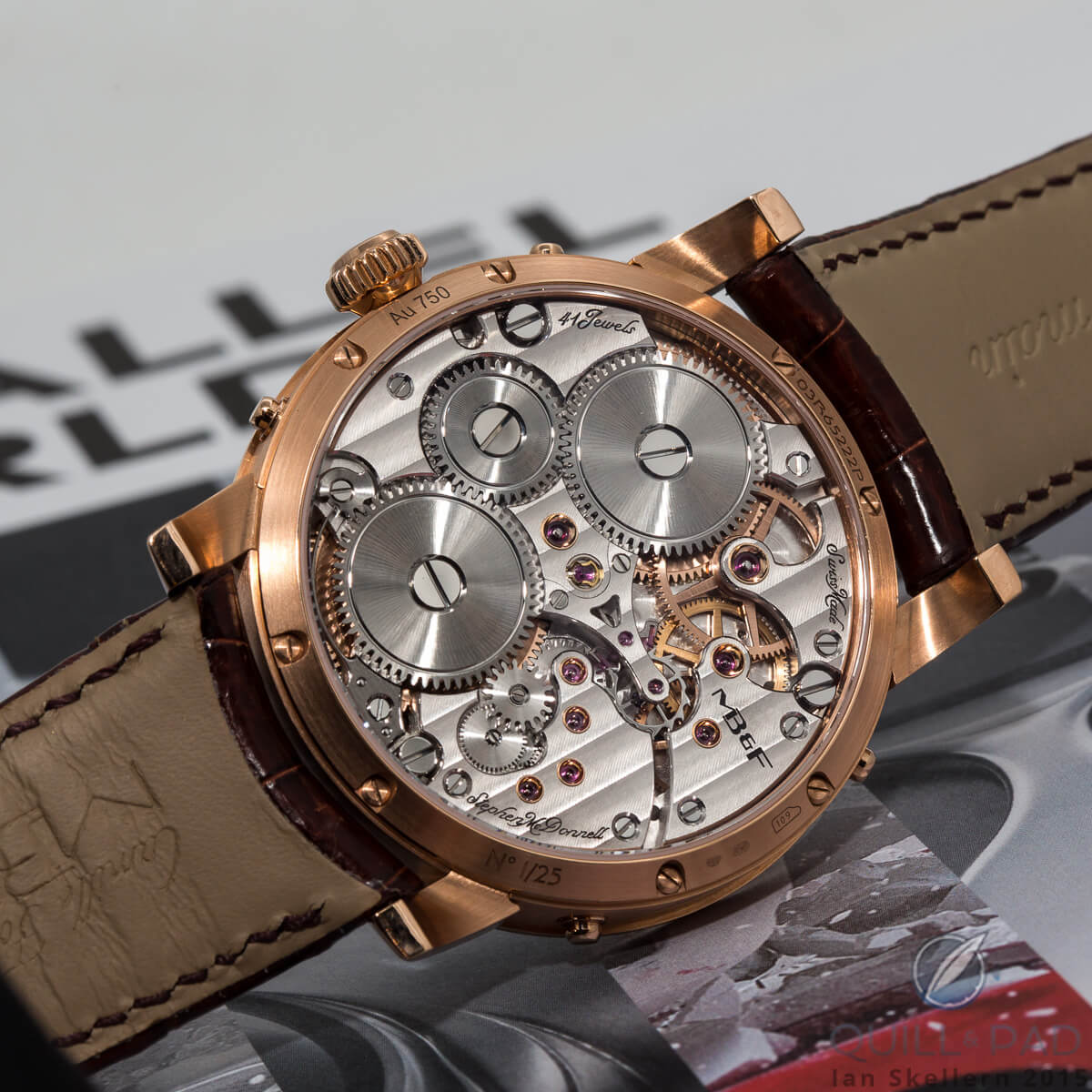
The movement of Legacy Perpetual is as beautifully hand finished as we have come to expect from MB&F
RS: Despite some remarkable competition, the very second that it was released I fell in love with the Legacy Machine Perpetual, with the passage of time only serving to enhance that love. Technically it’s impressive, with watchmaker Stephen McDonnell switching the mechanism from a base 31-day month to a base 28-day month, removing the precarious period when a traditional perpetual calendar will skip past any redundant days from the end of the actual month.
Furthermore, a simple pusher allows for the year to be set, avoiding the traditional method of rotating through the months. Despite such bravura, I would argue that it’s the visual aesthetic that has earned the Legacy Machines’ place in the hearts of so many watch lovers. Just look at that suspended balance wheel, those dials, the exposed mechanism; just look at them and tell me the LM Perpetual is not the winner!
MG: Leave it to Max Büsser and his team to turn something as classical as the perpetual calendar into something completely different. By literally putting the balance wheel on top of everything else, they have created a visual ecstasy out of one of the industry’s most cherished complications. Combine that with the user friendliness of the watch, and we have a winner that excels not only by visual appeal.

MB&F Legacy Machine Perpetual
Further reading: Why Legacy Machine Perpetual Catapults MB&F Into The Big League.
For more information, please visit www.gphg.org/horlogerie/en/watches/legacy-machine-perpetual.
Quick Facts MB&F Legacy Machine Perpetual
Case: 44 x 17.5 mm, platinum
Movement: manually wound, integrated perpetual calendar with complication on top of base plate
Functions: hours, minutes; perpetual calendar with day, date, month, retrograde leap year, power reserve indicator
Limitation: 25 pieces
Price: $176,000 / 181,500 Swiss francs
Predicted Winners
Ian: MB&F Legacy Machine Perpetual or Andreas Strehler Lune Exacte if MB&F wins Aiguille d’Or
Alex: MB&F Legacy Machine Perpetual
Gary: MB&F Legacy Machine Perpetual
Ryan: MB&F Legacy Machine Perpetual
Joshua: MB&F Legacy Machine Perpetual
Martin: Andreas Strehler Lune Exacte
And the winner of best Calendar watch at the 2016 GPHG went to the MB&F Legacy Machine Perpetual (see Why Legacy Machine Perpetual Catapults MB&F Into The Big League).
For more of our predictions in the 2016 Grand Prix d’Horlogerie de Genève (GPHG), please see:
Men
Tourbillons
Ladies
Ladies’ High-Mech
Artistic Crafts
Chronographs
Jewellery
Sports
Travel Time
Mechanical Exception
Petite Aiguille
Aiguille d’Or
Trackbacks & Pingbacks
-
[…] Category Ladies’ High-Mech Category Artistic Crafts Category Sport Category Calendar Category Travel Time Category Mechanical Exception Category Petite Aiguille Aiguille […]
-
[…] High-Mech Category Artistic Crafts Category Chronograph Category Jewellery Category Sport Category Calendar Category Mechanical Exception Category Petite […]
-
[…] Strehler is an independent watchmaker with Harry Winston Opus pedigree and one who has officially produced the world’s most accurate moon phase watch (find out more about the Lune Exacte in Predictions In The Calendar Category Of The 2016 Grand Prix d’Horlogerie de Genève). […]
-
[…] Further reading on the Perpetual Secular Calendar: Predictions In The Calendar Category Of The 2016 Grand Prix d’Horlogerie de Genève. […]
-
[…] de Genève (GPHG), please see: Tourbillon Category Chronograph Category Sport Category Calendar Category Travel Time Category Mechanical Exception Category Petite Aiguille Aiguille […]
-
[…] For more of our predictions in the 2016 Grand Prix d’Horlogerie de Genève (GPHG), please see: Predictions For The Men’s Category Predictions In The Tourbillon Category Predictions For The Ladies Category Predictions In The Ladies’ High-Mech Category Predictions In The Artistic Crafts Category Predictions In The Chronograph Category Predictions In The Jewellery Category Predictions (unanimous) In The Sports Category Predictions In The Calendar Category […]
Leave a Reply
Want to join the discussion?Feel free to contribute!

Watch of the Millenium for me! If I could, I would.
p.s. Probably unnecessarily, I should have pointed out that I referred to the MB&F PC!
Not necessary!